|
For eight weeks during the summer of 2010, eight students from area high schools faced exciting changes as they worked for Lewis and Clark National Historical Park as Youth Conservation Corps students. While they constructed trails, interpreted history and built boardwalks, they also filed stories and blogged about their summer experiences. 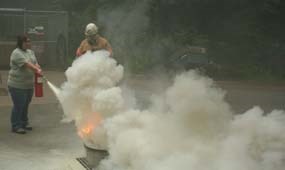
Week 8: "Adieu" It is time to say adieu to the 2010 Youth Conservation Corps students. In this final multimedia presentation, produced and edited by YCC student Roland Johansen, you will see the YCC 2010 crew, train, work, and have lots of fun. 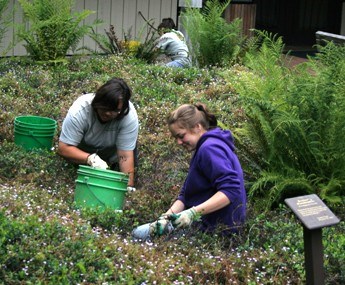
Week 7: "Summer Reflections" This summer, we participated in the Youth Conservation Corps, which is a program for High School students to experience working at various National Parks around the United States. We worked at the Lewis and Clark National Historical Park for eight weeks on projects like clearing trails, weeding invasive plants, painting the visitor center, and assisting with Junior Ranger Program. Usually the park has two students working each summer, but this year they decided to hire eight students instead. Working here together was a great experience for all for us. When we went camping at Mt. Rainier, we worked with their resource division. While there, we pulled invasive plants and learned about about their invasives at their park as opposed to ours. As well as pulling weeds, we also hiked some of the trails and explored their visitor center. "Being at our campsite was peaceful, fun, awesome, quiet, and just plain amazing!" said YCC Angelica Garcia. Working at Lewis and Clark National Historical Park wasn't always as easy as it may appear. We learned what we liked and did not like to do working together on and off the trails. We had to be flexible, work hard, and have determination in pulling that final root! "We like weeding because it gives us time to think," said Sidney Johnson and Angelica Garcia. Overall, working here at the park has been the most awesome experience in meeting and working with amazing people. -Brittany Olsen, Sidney Johnson, and Angelica Garcia 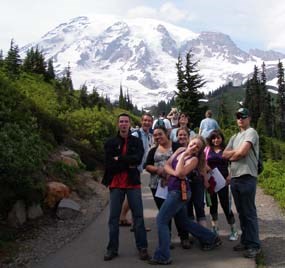
Week 6: "The Lewis and Clark Youth Conservation Corps students explore Mount Rainier National Park!" Hear the multimedia presentation of the Youth Conservation Corp' expedition to Mount Rainier National Park. Produced by YCC student Roland Johansen. 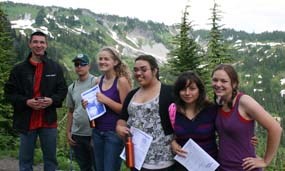
Week 5: "Brittany's Perspective on the Camping Trip to Mount Rainier National Park" A couple of weeks back we were asked to sign some papers to go on a camping trip to Mt. Rainier National Park. At first I wasn’t really thrilled to be going camping for three days, to somewhere I’ve never been before. But I thought about it and decided I’d give it a shot. When the deadline came to turn in our papers I was kind of glad to be going because that meant I’d be out of town for a while. The night before we were leaving to Mt. Rainier, I made Frog Eye Salad and Strawberry Pretzel salad for everyone. I don’t think people were too excited about eating my Frog Eye Salad, but I reassured them that there were no frog eyes in the dish. 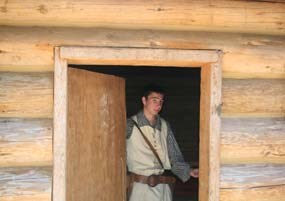
Week 4: "Roland's Reflections on working at Fort Clatsop" Walk with Youth Conservation Corps student Roland as he reflects on his experience working with visitors at the fort. This multimedia presentation was produced and edited by Roland Johansen. 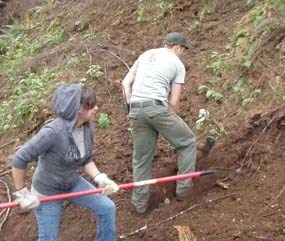
Week 3: "Angelica's View" Working at Lewis and Clark National Historical Park has been one of the best experiences in my life. If I was to tell you all the details from each job we do I would not finish telling you about it. I don’t have a favorite activity, but I will tell you about building the new trail with maintenance- nice and fun people. Building trails takes time and steps to do. As Park Rangers Blake and Doug clear the way by the cutting trees and branches, we, the YCC students and Park Ranger Lori and Josh follow with the next steps. After the way is clear we start using the Pulaskis’ we try to not dig too much or too little. A Pulaski is a tool with two different pointy sides one is like a pick ax and the other side, an ax head on its side. When that is done we follow by raking all the dirt, leaves and roots from the trees. We even out the trail so it’s not too bumpy or too tilted to a side. If it has holes we fill them with dirt. After the trail is even and wide enough to walk on, the rangers start hauling gravel in the toter, a motorized wheel barrel. We rake it well so that way when it rains it doesn’t get muddy. This past 5 weeks or so have been very productive! I can see that having more hands working in the trail can really decrease the time to fully complete the trail. All in all, building trails can sometimes be harder (heavier) than working in the Visitor Center, the Fort, Administration and Resource management, but it is interesting in a different way. I thank all the rangers and staff members for giving me this opportunity of working here and helping with this new trail project. I recommend that people come and hike this new trail. Even though it’s not quite complete I can see there has been a great amount of work done. -Angelica Garcia Semana 3: "Angélica Perspectivo" Trabajar en el Parque Histórico Nacional de Lewis y Clark ha sido una de las mejores experiencias en mi vida. Si tuviera que decirles todos los detalles de cada trabajo, no terminaría contándoles sobre ellos. No tengo una actividad favorita en el trabajo, pero les voy a contar sobre la construcción de un nuevo camino con las personas buenas y divertidas de mantenimiento. Construyendo caminos toma tiempo y pasos diferentes de hacer. Mientras los guardabosques del parque Blake y Doug limpian el camino cortando arboles y ramas, nosotros, los estudiantes de YCC, guardabosques Lori y Josh seguimos con los siguientes pasos. Después que el camino está limpio empezamos a usar los pulaskis', tratamos de no escarbar mucho ni muy poco. Un pulaski es una herramienta que tiene dos lados picudos. Un lado es como un pico hacha y el otro lado es como la cabeza de un hacha volteada para un lado. Cuando eso esta terminado rastrillamos toda la tierra, las hojas y las raíces de los arboles. Igualamos el camino para que no este desnivelado o inclinado para un lado o para arriba. Si el camino tiene posos lo llenamos con tierra. Cuando el camino esta anivelado y ancho suficientemente para caminar, los guardabosques empiezan a acarrear grava en un toter. Un toter es como una carretilla motorizada. Rastrillamos la grava bien para cuando llueva no haiga lodo İEstas últimas 5 o más semanas han sido muy productivas! Puedo ver que entre más manos ayuden construyendo el camino más rápido se termina plenamente. Construyendo caminos puede ser más difícil (pesado) que trabajar en el Centro de Visitantes, en las Cabañas, Administración, o en gestión de recursos, pero es interesante en otra manera. Le doy gracias a todo el personal y a los (las) guardabosques por darme la oportunidad de trabajar aquí y ayudarles con este nuevo proyecto. Yo recomiendo a las personas que hagan una caminata por el nuevo camino. Aunque todavía no esta totalmente terminado puedo ver que se ha hecho una gran cantidad de trabajo. -Angélica García 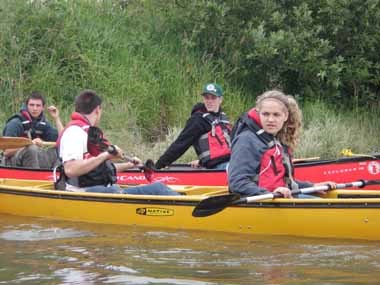
Photo by Sidney Johnson
Week 2: "Youth Conservation Corps Meets the Lewis and Clark River" The Youth Conservation Corps students had a special afternoon of paddling on the Lewis and Clark River. Join them through this multimedia presentation, produced by YCC student Roland Johansen and photography by Sidney Johnson. 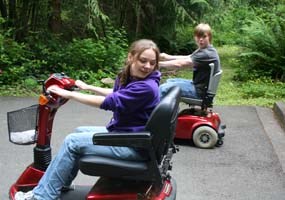
Week 1: "Brittany's Perspective" The day before the first day of my training at the Lewis and Clark National Historical Park, I was super nervous. I was afraid to meet new people let alone talk in front of people. My cousin saw this job on the Internet and told me about it, and I wasn't so thrilled to tell you the truth. Nature definitely was not one of my best subjects. So as I woke up in the morning with the butterflies in my stomach, I got up the courage to try and make it through this first week of training not knowing anyone. The first day was all over the place, we introduced ourselves with our favorite pizza topping. I'd have to say the most descriptive pizza topping was Dylan's, "New York style double stuffed pizza", mine was simple, Hawaiian pizza. During the rest of the day we went hiking, played games, and got an idea of where everything is at the park. It was a lot to take in but at least we got a lot of breaks and a long lunch. When I went home that day all I could talk about to my cousin, was how much I love working there, and I haven't even started officially. The next four days of that week were great for me. I got to meet a lot of the employees at the park, and they are all enjoyable to be around. Some of them are even funny if you can imagine a park ranger being humorous. My former job as a dump/log truck washer isn't as fun as working here at the National Park. Being here you have so many things to do, seeing new people and learning a whole lot about Lewis and Clark and invasive plants. We got to see the trails we would be helping on, and seeing the plants we need to pull in the Resource department. Washing trucks is boring and messy, you don't learn much from scrubbing muddy tires. Working at the Lewis and Clark National Historical Park should help me not to be so shy anymore. Speaking publicly is not one of my best qualities. When I first met the other YCC members we were all pretty quiet toward one another. As the week went on, we pretty much warmed up to the idea of getting stuck working together for the next seven weeks. They really are nice and funny people to hang out with, when I got to know them better. I'd have to say, knowing that at least one other person on the YCC's was just as scared to aim a fire extinguisher at a fire just as I was, was very relieving. One of the other fun things we did on training week was scooter training. Everyone had to try them at least once, so we knew how to use them for when a visitor needed one. After we were done training, we all got a chance to race. At that point I was nervous because all I could think was if I go too fast I'm going to tip over. Luckily I didn't, and it was very fun. I've learned not to race with Roland (YCC) and Will (Park Ranger), they cheat by stealing bottles. We all at some point had a little bit of an issue with inserting the key, and backing up properly. But if you came in now you will see that we are pro's now. Furthermore I made it through my week of training without any injuries or whining. I had so much fun I would love to come back and work here next summer. -Brittany Olsen |
Last updated: January 6, 2017
